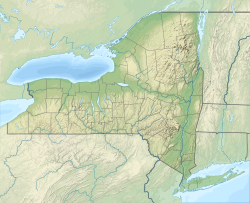| Oak Orchard Creek | |
|---|---|
 The mouth of the creek, at Point Breeze | |
| Location | |
| Country | United States |
| State | New York |
| Counties | Orleans, Genesee |
| Physical characteristics | |
| Source | |
| • location | Elba, Genesee County |
| • coordinates | 43°02′40″N78°12′44″W / 43.04444°N 78.21222°W [1] |
| Mouth | Lake Ontario |
• location | Carlton, Orleans County |
• coordinates | 43°22′18″N78°11′32″W / 43.37167°N 78.19222°W [1] |
| Discharge | |
| • location | Kenyonville [2] |
| • average | 346 cu ft/s (9.8 m3/s) |
Oak Orchard Creek (sometimes called Oak Orchard River) is a tributary of Lake Ontario in Orleans County, New York in the United States. [1]
Contents
The creek flows through Oak Orchard Creek Marsh, 600 acres (2.4 km2) of which were declared a National Natural Landmark in May 1973. [3] The marshlands through which Oak Orchard Creek flows are a major stopover points for migratory birds, and are protected by state- and federally-designated conservation areas.



